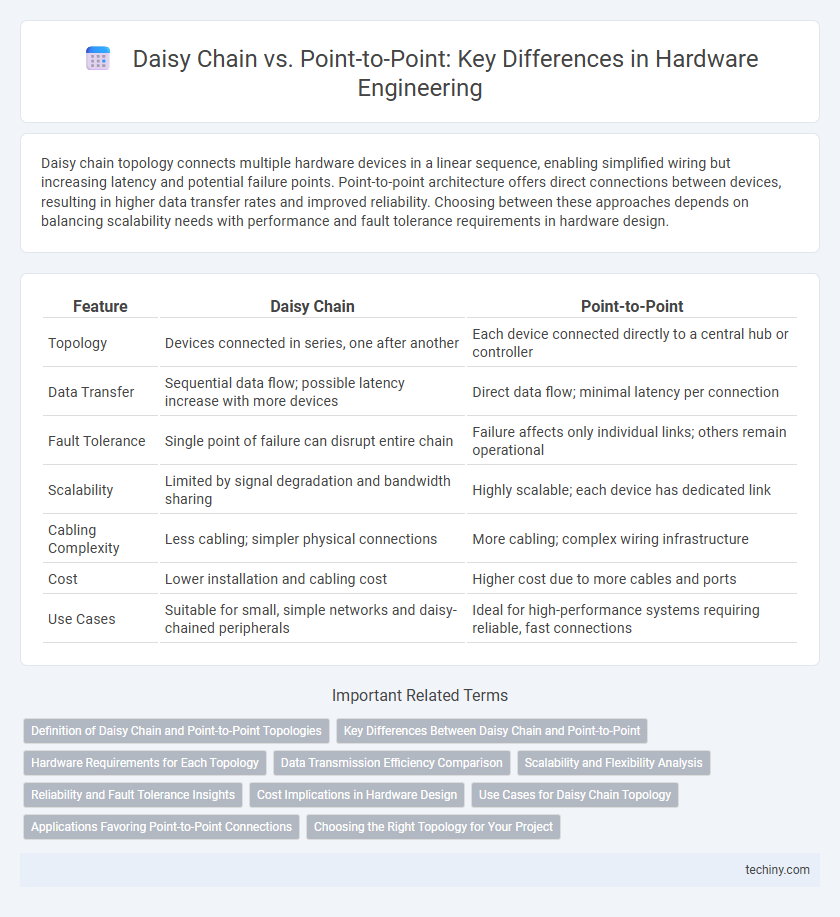Daisy chain topology connects multiple hardware devices in a linear sequence, enabling simplified wiring but increasing latency and potential failure points. Point-to-point architecture offers direct connections between devices, resulting in higher data transfer rates and improved reliability. Choosing between these approaches depends on balancing scalability needs with performance and fault tolerance requirements in hardware design.
Table of Comparison
| Feature | Daisy Chain | Point-to-Point |
|---|---|---|
| Topology | Devices connected in series, one after another | Each device connected directly to a central hub or controller |
| Data Transfer | Sequential data flow; possible latency increase with more devices | Direct data flow; minimal latency per connection |
| Fault Tolerance | Single point of failure can disrupt entire chain | Failure affects only individual links; others remain operational |
| Scalability | Limited by signal degradation and bandwidth sharing | Highly scalable; each device has dedicated link |
| Cabling Complexity | Less cabling; simpler physical connections | More cabling; complex wiring infrastructure |
| Cost | Lower installation and cabling cost | Higher cost due to more cables and ports |
| Use Cases | Suitable for small, simple networks and daisy-chained peripherals | Ideal for high-performance systems requiring reliable, fast connections |
Definition of Daisy Chain and Point-to-Point Topologies
Daisy chain topology connects multiple hardware devices sequentially, forming a linear data path where each device links to the next in a single series. Point-to-point topology establishes a direct, dedicated connection between two hardware devices, enabling high-speed and low-latency communication. These contrasting methods impact system performance, fault tolerance, and scalability in hardware engineering designs.
Key Differences Between Daisy Chain and Point-to-Point
Daisy chain topology connects multiple devices in a linear sequence, sharing a single communication path, which can lead to signal degradation and increased latency as more devices are added. Point-to-point topology establishes a dedicated link between two devices, providing higher reliability, faster data transfer rates, and simpler troubleshooting due to isolated connections. Key differences include scalability, with point-to-point excelling in performance and fault tolerance, while daisy chain offers cost-effective wiring at the expense of potential performance bottlenecks.
Hardware Requirements for Each Topology
Daisy chain topology requires fewer physical connectors and simplified cabling, minimizing hardware complexity but increasing dependence on intermediate devices for signal integrity. Point-to-point topology demands dedicated wiring and connectors for each device pair, resulting in more cables and hardware components but offering enhanced signal quality and fault isolation. Hardware design for daisy chains emphasizes bus termination and signal repeaters, whereas point-to-point systems focus on dedicated interface ports and robust connector standards.
Data Transmission Efficiency Comparison
Daisy chain and point-to-point topologies significantly differ in data transmission efficiency, with point-to-point offering dedicated, high-speed links between devices, minimizing latency and maximizing throughput. Daisy chain connections share bandwidth among devices, leading to increased transmission delays and potential bottlenecks, especially as the number of connected devices grows. Point-to-point architecture is preferable for applications demanding consistent low-latency communication and high data integrity.
Scalability and Flexibility Analysis
Daisy Chain topology offers limited scalability due to bandwidth sharing and increased latency as devices are added, constraining performance in large hardware systems. Point-to-Point connections provide superior scalability by enabling dedicated bandwidth and lower latency, which supports higher data throughput and more flexible system expansion. Flexibility is enhanced in Point-to-Point designs through independent device management and easier fault isolation, whereas Daisy Chain configurations often struggle with complex troubleshooting and reduced adaptability under scaling demands.
Reliability and Fault Tolerance Insights
Point-to-point connections offer superior reliability by isolating faults to individual links, preventing widespread system failures common in daisy chain configurations. Daisy chain architectures increase the risk of cascading failures, where a single point of failure disrupts the entire chain, reducing overall fault tolerance. Hardware engineers prioritize point-to-point topologies in mission-critical systems to enhance fault tolerance and maintain continuous operation under adverse conditions.
Cost Implications in Hardware Design
Daisy chain topology significantly reduces wiring complexity and material costs in hardware design by linking multiple devices with a single communication line, minimizing the need for extensive cabling and connectors. Point-to-point connections, while offering improved signal integrity and performance, increase overall expenses due to the requirement for dedicated cabling and interfaces for each device pairing. Cost optimization in hardware engineering involves balancing the trade-offs between daisy chain's reduced infrastructure costs and point-to-point's higher reliability and scalability benefits.
Use Cases for Daisy Chain Topology
Daisy chain topology is ideal for connecting devices in a sequential manner, such as USB peripherals or LED lighting systems, where simplicity and reduced cabling are crucial. This topology allows easy expansion and maintenance in environments like industrial automation and audio equipment setups, minimizing the need for multiple ports or switches. It supports cost-effective scalability but may introduce latency, making it less suitable for high-speed or high-bandwidth applications compared to point-to-point connections.
Applications Favoring Point-to-Point Connections
Point-to-point connections are favored in high-performance computing applications requiring low latency and high bandwidth, such as server interconnects and PCIe interfaces. This topology minimizes signal interference and crosstalk compared to daisy chain configurations, ensuring reliable and scalable data transfer in complex hardware systems. Furthermore, point-to-point connections enhance fault isolation, making them ideal for mission-critical embedded systems and high-speed data acquisition hardware.
Choosing the Right Topology for Your Project
Daisy chain topology links devices in a linear sequence, reducing cable clutter but potentially increasing latency and failure risk in long chains. Point-to-point topology creates direct connections between devices, offering superior data transfer speeds and reliability essential for high-performance hardware engineering projects. Selecting the right topology depends on project requirements for scalability, signal integrity, and fault tolerance.
Daisy Chain vs Point-to-Point Infographic

 techiny.com
techiny.com